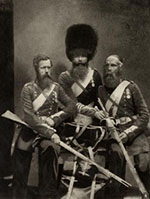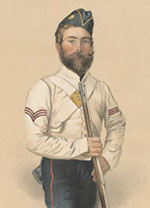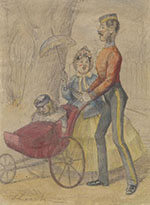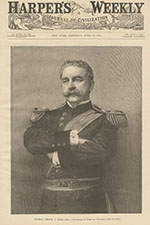The Democratization of Military Portraiture in Nineteenth Century England
B. Dawn Dunley
Victorian England considered war an instrument for heroism, and its artists depicted it as such: the iconography of military portraits rarely included death, danger or suffering. The manner in which the soldier was portrayed depended upon the public's perception of him. This, and the fact that the aristocracy and land-owning gentry comprised the majority of the officer corps, were the main reasons that military portraits of the early nineteenth century were executed in the grand manner and exhibited aristocratic overtones. In the mid-nineteenth century, however, new artistic and social developments changed the format of the military portrait. The invention of photography in 1839 was an influential catalyst in the democratization of military portraiture, as was the public's change in attitude after the Crimean War (1854-1856). Unlike previous art forms, photography's influence reached beyond the physical portrayal to society. Its impact altered not only the format of the military portrait but whom it depicted and its patrons as well. By mid-century the common soldier of the ranks was often the subject of military portraiture. Similarly, the aristocrats were no longer the sole patrons of military portraiture. Thus, it is evident that as photography influenced art, parallel changes occurred in society. By democratizing the military portrait, photography helped to diminish the artistic barriers that had previously separated society.
The aristocracy and gentry had always been in command of Britain's military for one primary reason; being landowners, they were believed to have more to protect and thus to be better qualified for command. In 1830 57% of the major-generals and the lieutenant-generals were members of the aristocracy. Control of the army by the titled and wealthy was almost inevitable, since potential officers had to buy not only their original commissions but also each subsequent promotion in rank. Although the monarchy opposed this system, its financial profitability outweighed the reasons to abolish it. As a result, money, not ability, enabled a man to have a military career. Thus, it was the wealthy patrician who commissioned or purchased the portrait of the military hero, in most instances also a member of the upper class. The military art produced during the period prior to the Crimean War reflects this. At this time it was not the general public but the art-buying public that molded the image of the soldier as a glorified and valiant hero, directly reflecting his aristocratic status.
The thirty-nine years of peace prior to England's involvement in the Crimea (1854-1856) produced no new military heroes and few military portraits. Those that were painted show a noticeable decline from the majestic style that had previously characterized military portraiture. This decline in the volume of formal military portraiture may also have been brought about by a change in the public attitude toward the common soldier. In the recent past the soldier had been viewed as a "potentially dangerous wastrel." A young recruit wrote in his journal that his mother would have preferred him "in his grave than gone for a soldier." When discharged from the military, soldiers rarely had a trade that would enable them to secure employment. Army pensions were not enough to live on and, because of the long enlistment requirement (twenty-one years), few soldiers had friends or family with whom they could live upon discharge. Indeed, soldiers were obligated upon enlistment to swear that they were not married and were encouraged to break all ties with home and family.
Thus, many soldiers became vagrants and, in the eyes of the ruling class, were a threat to society. All these factors made the soldier of the ranks an unlikely role model for inclusion in any type of artistic depiction.
It was not until the Crimean War that the public's view of the common
soldier became more sympathetic. Britain had not been engaged at war
since Waterloo, and the public responded enthusiastically to the declaration
of war, believing that the Crimean campaign would be a short and
successful one. Unfortunately, the army of 1854 still resembled the army of
1815 in many ways. The soldiers wore the same uniforms, carried similar
weapons, and endured the same low pay, poor food and insufficient
housing. There had been few advances in battle tactics and in military
technology. Historians have often called the Crimean War the most futile
war the British ever fought. Although it has also been called the first
modern war, since it employed for the first time telegraphic communication,
a supply railway, a nursing staff and field kitchens, it was arguably the
most mismanaged.
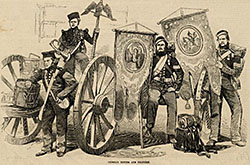 William Howard Russell of The Times went to the
Crimea to report on the war's progress firsthand. It was his dispatches that
alerted readers back home to the gross mismanagement by the officers and
the ill-equipped troops. These honest dispatches portrayed the soldiers as
heroes fighting under adverse circumstances under indifferent and incompetent
officers. His accounts of the outbreak of cholera while en route to
Balaclava and of the horrifying living conditions during the harsh Russian
winters shocked the nation at home, which had believed that Britain would
secure a quick victory. Russell's reports spurred an unprecedented public
concern for the common soldier, and the troops returned home to a society
that did not, as in the past, consider them outcasts but looked upon them
as heroes who had overcome the hardships of the Crimea and fought
gallantly under adverse circumstances and improper management. This
new admiration for the soldiers of the ranks was shared by Queen Victoria,
who established the Victoria Cross, the first medal that could be awarded
to a soldier in the ranks.
William Howard Russell of The Times went to the
Crimea to report on the war's progress firsthand. It was his dispatches that
alerted readers back home to the gross mismanagement by the officers and
the ill-equipped troops. These honest dispatches portrayed the soldiers as
heroes fighting under adverse circumstances under indifferent and incompetent
officers. His accounts of the outbreak of cholera while en route to
Balaclava and of the horrifying living conditions during the harsh Russian
winters shocked the nation at home, which had believed that Britain would
secure a quick victory. Russell's reports spurred an unprecedented public
concern for the common soldier, and the troops returned home to a society
that did not, as in the past, consider them outcasts but looked upon them
as heroes who had overcome the hardships of the Crimea and fought
gallantly under adverse circumstances and improper management. This
new admiration for the soldiers of the ranks was shared by Queen Victoria,
who established the Victoria Cross, the first medal that could be awarded
to a soldier in the ranks.
The change in attitude toward the common soldier manifested itself in other ways as well. The Patriotic Fund was established to raise money for the families of those who had fought and died in the Crimea, and portraits of soldiers who died in the Crimea were auctioned for its benefit. Purchasing a lithograph of a Crimean veteran indicated the buyer's nationalistic pride and support of the army, and also helped a widow and her children. Thus, these veterans, neither national heroes or honored officers, were depicted as heroes of the ranks who had died fighting for their country. Other forms of military portraiture produced during this time also reflect the middle class's new view of the common soldier: he is now portrayed as a respectable patriot, a member of a profession no longer embarrassing but newly noble and honorable.
After the Crimean War, the Cardwell Reforms were the culmination of the efforts to aid the soldiers of the ranks and to further democratize the military. The position of officer was opened to all, achieved by merit and not by wealth or class standing. Other reforms permitted more soldiers to marry, indicating the new belief that married men, not bachelors, make the best soldiers. Soldiers now come to be depicted more and more frequently in domestic scenes. Home and family were believed to be institutions encouraging morality, and the soldier's association with them gave him a new-found respectability. The volunteer movement also influenced the public perception of the army. Founded in 1859, the Volunteer Force was made up of civilians, primarily from the middle class, and was thus a challenge to a military traditionally dominated by the aristocracy. Although all the classes were represented, there were at first few volunteers from the lowest classes because of the requirement that one had to provide one's own uniform. In 1863, however, an act was passed calling for the army to provide uniforms and offering incentives for the volunteers to attend drill and rifle practice." With the participation of all classes of men and popular support from both the government and the public, the Volunteer Force gave the army a new respectability. Now the middle-class volunteers had portraits made of themselves in their uniforms in an attempt to associate themselves with the aristocratic military portrait tradition.
In the mid-nineteenth century, it was the rising middle class that had the greatest effect on how the soldier was viewed and was portrayed in art. This new level of society arose as a direct result of the industrialization of England during the early nineteenth century. In general. the middle class was highly materialistic and strove to affirm its place in society. It endeavored to establish its familial tradition by much the same means as the upper class always had affirmed its place-through portraiture. The rise of the bourgeoisie had a direct influence on the portrait market. Whereas previously it was only the aristocracy and upper classes that had commissioned military portraits, now the middle classes also participated in this market. Wanting to be associated neither with the decadent aristocracy nor with the immoral lower classes, they attempted to solidify their social status through their families. The middle class strove to show its high moral character, not its wealth, through portraiture. Military portraits had always been reserved for aristocratic landed gentlemen. Now that the military was a respectable profession for the middle class, military portraiture took on a new meaning and at the same time provided a link with the previous military elite.
One of the first forms of portraiture to be patronized by the middle class was the miniature. The miniature portrait imitated the formal style of the court portraitists but, because of its size, was much less expensive and therefore available to a wider audience. Miniature portraits, although popular with the middle class. gave way to an even cheaper method of portraiture whose popularity would soon overshadow miniature paintings. This revolutionary method was photography. Although invented in 1839, only in the 1850s did photography make an obvious impact upon portraiture. In 1851 Frederick Scott Archer developed the wet-plate process or collodion method, a process which reduced exposure time and also allowed multiple images to be printed from a single negative at a price considerably lower than the daguerreotype.
In its infancy, portrait photography was of extremely high quality. Unfortunately, because of increased demand and new technical developments that allowed almost anyone to learn to make photographs, portrait quality rapidly decreased. By 1856, 284 photography studios were established in London, a drastic increase from the twelve or so in 1851. By the mid-1850s miniature painting had almost disappeared due to the burgeoning demand for the accurate and realistic portraits that photography produced. Yet there was still a market for small portraits, a demand filled by the invention of the photographic carte-de-visite, created for and utilized by an increasingly mobile society whose names might not be easily recognized. The portrait on the front and the name on the back helped one identify or recall a visitor. Because of its small size, low price, and novelty, the carte was an immediate success. Although originally designed as an illustrated calling card, it was seldom used as such. In England 300 to 400 million cartes were sold yearly from 1861 through 1867, and the rage for them was known as "cartomania." The carte-de-visite revolutionized portrait photography because of its affordability and availability to the masses. It remained small in size (10.5 x 6 cm), yet the backdrop for sitters varied, as did the photographer's advertisement on the backs of the mounts.
At first it was royalty and the upper class who ordered cartes of themselves. But during the 1860s and 1870s when cartomania was at its height, the cartes were mass-produced, and the cartes-de-visite album became an important part of the Victorian parlor. Many people collected photographs of the royal family and of other prominent men and women; these cartes would be displayed at the beginning of the album, followed by those of family and friends. The album was often put in a conspicuous place for visitors to browse through so as to impress them with the cartes of well known and famous people. The carte-de-visite album came to exemplify the middle class's ongoing quest for status.
The carte-de-visite photographer even made his way to the battlefield, posing the soldier against a backdrop of tents or a cannon. The carte played an important part in soothing the pain of separation from home, for a soldier could send cartes home to his family to reassure them of his safety. The carte-de-visite was a significant development in military portraiture, for officers as well as enlisted soldiers sat for them and, of course, a soldier of the ranks could be photographed in a setting similar to that used for an officer. Soldiers all posed similarly for their cartes, usually standing with one arm resting on a prop and the other holding a rifle, the only variation being in the backdrops. In this manner photography, specifically the carte-de-visite, truly democratized military portraiture. The photographic portrait was popular with the middle class because it captured the likeness of the sitter rapidly and inexpensively, and thus rivaled painted portraits and painting in general as a serious art. Yet the informality of the carte-de-visite was a major deterrent to continued enthusiasm. By the mid-1860s its popularity had begun to subside because of its mass production and resulting decreased quality, and because of the inevitable boredom with its format. The cabinet card photograph, first introduced in England in 1866, replaced the carte in popularity. It was larger (16.4 x 11 cm.) and more formal in appearance, recalling the portraits that existed before the era of photography. In an era of continued concern for the soldier, military portraiture now moved toward realistic and even graphic representations of the war veteran made possible by the direct nature of photography. Never before had soldiers been depicted in a way that demonstrated so specifically the grim realities of war. Wounded veterans returning from the Crimea were visited in hospitals by Queen Victoria. The photographs of these veterans, accurate and realistic depictions of the effects of war are considered by many to be the beginning of documentary photography.
The carte-de-visite portrait of the soldier, while a popular type of military portrait, was not the only format used during the second half of the nineteenth century. Because of photography and its influence, military portraiture was no longer confined to the traditional formats, and photographic portraits of soldiers appeared in new places. For instance, soon after photography's inception, engravings and wood engravings after photographs were published in the newspapers, while previously these journals had been illustrated with wood engravings after artist's sketches. The public's interest in the Crimean War sparked other portrait possibilities as well. In the fall of 1854, Roger Fenton was commissioned by Thomas Agnew, a well-known printseller, to go to the Crimea and photograph "the people and scenes of historical interest in the war. His photographs, published between November 1855 and April 1856, were then bound and sold as five different portfolios, one entitled Historical Portrait Gallery. These photographs primarily show officers gathered about, relaxing after the day's battle or lounging with the enlisted men: the casualness of the photographs and the absence of "formal" poses are noteworthy. Although Fenton's exposure time was as low as three seconds, it was still not quick enough to capture the action of battle, however, and thus he did no true battle photographs.
In the late nineteenth century, photographic military portraits are not only seen in a wider variety of places but are also used as models for a variety of purposes. Most noticeable is their use by artists in making painted portraits. Just as engravings were made after paintings, now paintings are executed after photographs. In many instances only the features of the sitter were copied, not the pose. Many portraits of deceased soldiers were executed from photographs. Unlike the photographer, who captured with his camera the true image of the sitter, the painter could improve one's flaws and idealize what the camera had portrayed realistically. The second half of the nineteenth century, then, witnessed an important change in the portrayal of the common soldier. Of the reasons for this transformation, the most significant was the campaign in the Crimea. The hardships the soldiers endured there shocked the Britons at home and propelled massive reforms in the constitution of the army. This transformation was also, in large part, due to the increasing influence of the newly emerging middle class. Perhaps the most significant factor effecting military portraiture was photography. Photography not only democratized a genre previously reserved for the aristocratic military elite, but also democratized society. Available to almost anyone, it diminished the artistic barriers that had once divided society.

